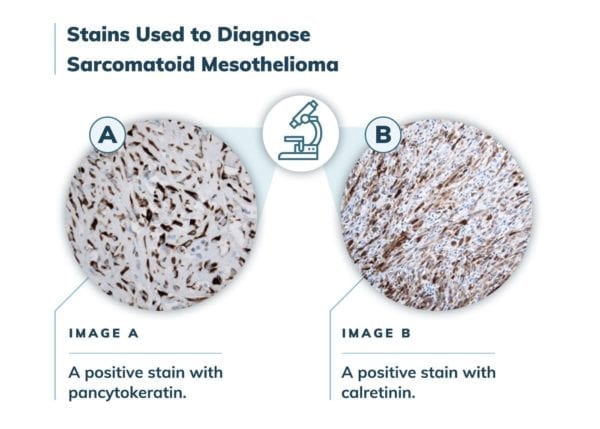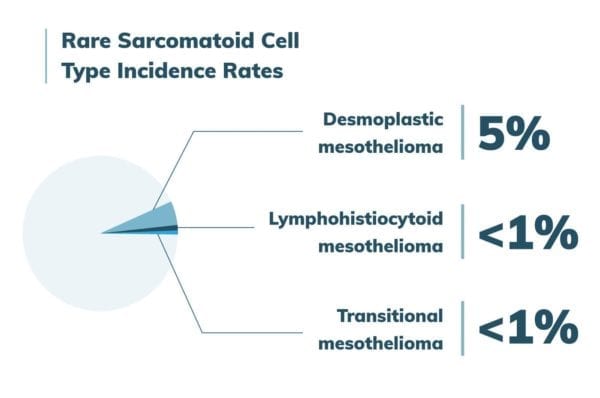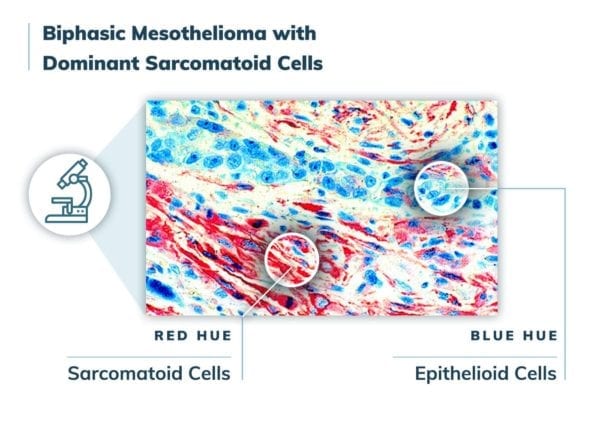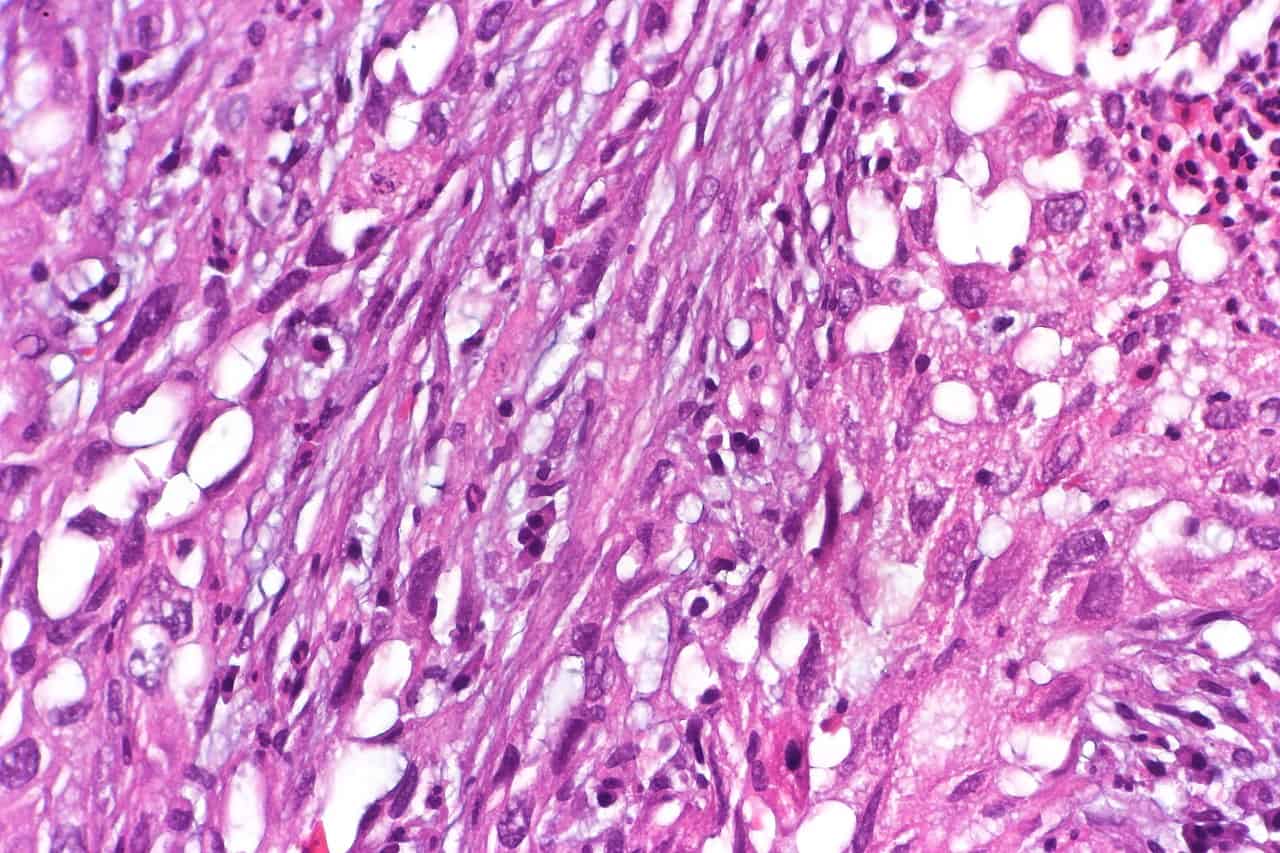01. Overview
What Is Sarcomatoid Mesothelioma?
Sarcomatoid mesothelioma is a less common cell type. It accounts for about 10 – 15% of allpleural mesothelioma diagnosesand 4% ofperitoneal mesothelioma diagnoses.
There are several defining characteristics that can help identify sarcomatoid cells:
- An oval, elongated shape with a large nucleus
- Multiple nuclei in some cells
- Unstructured formation in fibrous nodes or lesions
- Distant cell formation that is faster tometastasizethan other cell types
Because sarcomatoid cells are notable for their oblong, spindle shape, sarcomatoid mesothelioma is also referred to as spindle cell or sarcomatous mesothelioma.
Compared to othermesothelioma cell types, malignant sarcomatoid cells are more aggressive. This type ofmesothelioma canceris also considered more difficult to diagnose and treat. Sarcomatoid cells mimic healthy cells and are also frequently misdiagnosed.
02. Symptoms
Sarcomatoid Mesothelioma Symptoms
Malignant sarcomatoidmesothelioma symptomsmay take 10 – 50 years to develop. Patients may experience different symptoms depending on where the cancer develops.
Sarcomatoid cells are most common in malignant pleural mesothelioma, which impacts the lining of the lungs. In rare cases, patients may be diagnosed with sarcomatoid peritoneal mesothelioma. This type of mesothelioma develops in the abdominal lining.
Because malignant sarcomatoid cells spread quickly, sarcomatoid patients may experience worsening symptoms earlier than patients with epithelioid or biphasic cell types.
Resources for Mesothelioma Patients
03. Diagnosis
Diagnosing Sarcomatoid Mesothelioma
Properly identifying mesothelioma cell type is an important aspect of the diagnostic process. Sarcomatoid malignant mesothelioma is difficult to accurately diagnose because of its rarity and resemblance to other conditions.
Diagnosis typically begins withimaging tests, including an X-ray and CT scan. These tests will identify any visible tumors or excess fluid in the chest cavity. If cancer is suspected, doctors may order a blood test. This test identifiesbiomarkers that can differentiate mesotheliomafrom other conditions.
Abiopsyis the most important step in making an accurate sarcomatoid mesothelioma diagnosis. Cell type can be determined through a tissue biopsy and analyses of the sample, such as immunohistochemistry. This is a staining method that uses specific antibodies to isolate antigens or proteins in the tissue sample.
Through an immunohistochemical stain, a pathologist can identify if a tumor is benign or malignant, as well as determine cell type, stage and prognosis.
Several immunohistochemical markers can indicate mesothelioma. Studies have found stains that test positive for proteins calretinin and D2-40, in combination with the antibody pancytokeratin, are the most accurate indicator of sarcomatoid mesothelioma.

多个活检可能需要确定a patients’ tumors solely exhibit sarcomatoid cells. In some cases, epithelioid cells may also be present, indicatingbiphasic mesothelioma. Additional tests may also be needed to make an accurate differential diagnosis.
Common misdiagnoses of sarcomatoid mesothelioma include:
- Fibrous pleurisy
- Fibrous tumors
- Fibrosarcoma
- Metastasized renal sarcoma
- Non-Hodgkin’s lymphoma
- Pleural liposarcoma
- Sarcomatoid carcinoma
- Soft tissue sarcomas
Rare Sarcomatoid Cell Types
 In some cases, sarcomatoid mesothelioma may also be differentiated as severalrare cell types. These cell types are known for rapid metastasis and poor prognosis. These subtypes may have even more limited treatment options than standard sarcomatoid tumors.
In some cases, sarcomatoid mesothelioma may also be differentiated as severalrare cell types. These cell types are known for rapid metastasis and poor prognosis. These subtypes may have even more limited treatment options than standard sarcomatoid tumors.
- Desmoplastic mesothelioma:Desmoplastic cells often form without a defined pattern. Desmoplastic mesothelioma is most common in the pleura (lining of the lungs), but has also presented in cases of peritoneal and testicular mesothelioma. It accounts for about 5% of all diagnoses. Studies have found an average life expectancy of 3.8 months.
- Lymphohistiocytoid mesothelioma:This rare form accounts for less than 1% of all diagnoses. It typically forms in the pleura. Lymphohistiocytoid mesothelioma indicates tumors are made of a variety of cells, including epithelial cells and immune cells, such as lymphocytes and plasma cells. Studies have found an average survival time of two to 20 months.
- Transitional mesothelioma:Transitional cells develop similarly to other subtypes, but are characterized by a plump spindle shape. The cells sometimes closely resemble epithelial cells, making diagnosis difficult. These tumors are rare, with only a few case reports referencing the subtype.
04. Prognosis
Sarcomatoid Mesothelioma Prognosis
Sarcomatoid mesothelioma has the least favorable prognosis compared to the other common cell types. Studies have shownlife expectanciesranging from one month to about 28 months. The majority of patients face a median survival of six months or less.
An individual’s prognosis will also depend on the type of mesothelioma and stage at diagnosis, as well as the patient’s age, gender and overall health.
 Patients with biphasic mesothelioma may face a worse prognosis if sarcomatoid cells are more dominant than epithelioid. Biphasic mesothelioma patients typically have a life expectancy of about one year. However, if sarcomatoid cells make up more than 10% of the tumor, patients may have more limited treatment options and a worse prognosis.
Patients with biphasic mesothelioma may face a worse prognosis if sarcomatoid cells are more dominant than epithelioid. Biphasic mesothelioma patients typically have a life expectancy of about one year. However, if sarcomatoid cells make up more than 10% of the tumor, patients may have more limited treatment options and a worse prognosis.
05. Treatment
Sarcomatoid Mesothelioma Treatment
Research shows sarcomatoid mesothelioma is the most difficult to treat of all cell types. Studies suggest the cells are resistant to many standard therapies. Because malignant sarcomatoid mesothelioma spreads quickly throughout the body, surgery may not be a viable option for many patients.
Chemotherapyis often a first-line treatment for sarcomatoid mesothelioma. Though some studies show the cells can be resistant to chemotherapy, research suggests the treatment may extend survival in some cases.
One study examined 137 pleural sarcomatoid mesothelioma patients between 2000 and 2014. Researchers found:
- 19 patients had a positive response to chemotherapy treatment, meaning disease progression slowed or stopped during treatment.
- Patients with positive responses received chemotherapy as a first-line treatment.
- Sarcomatoid patients experienced a 13.9% response rate compared to a 21.9% response rate across all types of mesothelioma.
Immunotherapy treatmentshave also shown promise in clinical trials for sarcomatoid mesothelioma. Early research suggests it may be an effective option for patients with sarcomatoid mesothelioma who previously received chemotherapy. Some early evidence indicates sarcomatoid mesothelioma may be more responsive to immunotherapy than other cell types.
Radiation therapymay also be applied in some cases. It is often used as apalliative treatmentto lessen symptoms and improve a patient’s quality of life.
Research continues to investigate possible treatment combinations to improve life expectancy for sarcomatoid mesothelioma patients.










